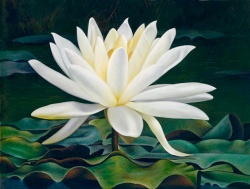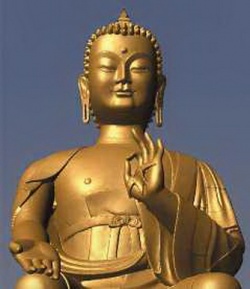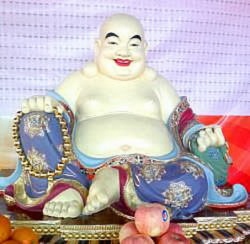The White Lotus Sect
The Bailianjiao 白蓮教 "White Lotus Sect" was a millenarian movement with Buddhist traditions that several times in history ignited large-scale popular uprisings against the ruling dynasties. The religious background of the White Lotus Sect goes back to the Pure Land School (Jingtujing) whose oldest patriarch, Huiyuan 慧遠 (334-416 CE), founded White Lotus Societies (bailianshe 白蓮社 or lianshe 蓮社 "Lotus Societies") in Donglin Monastery 東林寺 near Mt. Lushan 廬山. During the Northern Song period 北宋 (960-1126) White Lotus societies spread over all southern China. They were supported by monasteries as well as by rich landowners. In the mid-12th century the monk Cizhao 慈照 (worldly name Mao Ziyuan 茅子元) founded a new Buddhist School out of these societies, the White Lotus School (bailianzong 白蓮宗). The adherents of this school venerated the Amitabha Buddha 阿彌陀佛 and observed the five Buddhist rules of discipline (wujie 五戒: not killing, not stealing, not indulging in pleasures, not speaking bad words, not drinking) that were also a focal point of the Pure Land teaching.
Mao Ziyuan also adopted the method of the Tiantai School 天臺宗 to illustrate the teachings of the Buddha by drawings and pictures, which made it much easier to attract a wider followership. He also compiled confessional rules for daily worship, the Bailian chenchao chanyi 白蓮晨朝懺儀. In order to connect the scattered Lotus Societies he erected a Lotus Repentance Temple (Lianchantang 蓮懺堂) on the shores of Lake Dinghshan 淀山湖 near Kunshan 昆山, Jiangsu, adopted the title of Master (daoshi 導師) and assembled an auditorium to which he preached the teachings of the White Lotus School.
The newly founded White Lotus School was officially forbidden, and Mao Ziyuan had to leave Kunshan for Jiujiang 九江, Jiangsi. Yet because the teachings of his school were quite simple and easy to understand, the White Lotus Sect ("sect" in the sense of not being an officially acknowledged confession) attracted a lot of adherents not only in the Lower Yangtse region, but also in other parts of China. When the Mongols founded the Yuan dynasty 元 (1279-1368), the White Lotus School was officially acknowledged and even sponsored by the government.
It therefore became such an important branch of Buddhism that some believers even participated in the propagation of the faith as "Lotus people" (liandaoren 蓮道人) in private temples at home (tang'an 堂庵). Because they retained the everyday clothes and did not shave their heads, they were also called "hairy monks" (faseng 髮僧). Their private temples became such important clerical institutions that sons commonly inherited their father's duty of managing these semi-public prayer halls. The most popular deities were the Amitabha Buddha, the Guanyin Bodhisattva, and the 大勢至 XXX (together called the Three Amida Saints 彌陀三聖). The adherents prayed for health and fortune, and rich believers sponsered the building of official institutions like streets, bridges or temples. The owners of private temples often belonged to the most wealthy families in the cities and had close ties to the government.
In the course of time the teachings of Mao Ziyuan changed somewhat, especially among the common populace that developed their own ideas of the White Lotus religion. It was a very popular belief that the Amitabha Buddha would descend from Heaven as a redeemer of mankind. Adherents of this millenarian branch of the White Lotus School assembled at night and soon began to rise weapons against the Yuan dynasty in order to hasten the advent of the Amitabha Buddha or the Bodhisattva Maitreya 彌勒佛. In 1308 therefore, the Yuan court prohibited the White Lotus School in total and was only allowed open confession again a few years later. In 1322 it was declared illegal again because more and more White Lotus groups had begun to fight openly against local governments. The most important leaders of White Lotus rebel groups were Han Shantong 韓山童, Liu Futong 劉福通, Xu Shouhui 徐壽輝 and Zou Pusheng 鄒普勝. Their adherents fought to topple the Yuan dynasty and to welcome the "King of Brilliance" (mingwang 明王), i.e. the Maitreya Boddhisattva. The White Lotus groups constituted indeed an important reason for the downfall of the Yuan dynasty.
Based on this experience, the White Lotus School was prohibited under the Ming dynasty 明 (1368-1644), and for good reasons, because the foundation of the new dynasty was no reason to cease belief in the advent of a redeemer deity. During the early Ming period, White Lotus uprisings in all provinces were successfully put down. The various secret White Lotus societes later changed their names and were so not easily to be recognized as White Lotus offsprings. They adopted names like "teaching" of the Jinchan 金禪教 "Golden dhyana", Wuwei 無爲教 "Non-activity", Longhua 龍華教 "Flower of the Dragon", Wukong 悟空教 "Aware of the Voidness", Huanyuan 還源教 "Back to the Origin", Yuandun 圓頓教 "XXX", Hongyang 弘陽教 "Vast Yang", Mile 彌勒教 "Maitreya", Jingkong 淨空教 "Pure Voidness", Dacheng 大成教 "Great Completeness", Sanjiao 三陽教 "Three Yang", Hunyuan 混源教 "Origin of the Primordial Chaos", Wenxiang 聞香教 "Sensing the perfume", or Luodao 羅道教 "Arhat Way (?)". Because they were not allowed to establish a central authority, their rituals and services differed from each other, as well as the central deities venerated by the adherents, albeit the most important deity for most White Lotus sects was the Maitreya.
From the Zhengde reign on a new deity appeared among White Lotus adherents, namely the Wusheng Laomu 無生老母 "Birthless Old Mother" that was seen as a form of transcendent Buddha that never incarnated but ever existed without coming into being or transforming into a non-being form. She would nevertheless come down upon earth in the human shape of children, would protect them from harm and guide them safely back to Heaven, the "home of the true voidness" (zhenkong jiaxiang 真空家鄉). The different schools also used different writings to propagate their faith.
The behaviour of these various groups toward the government was therefore also not stringent. While some cooperated as normal religious institutions, others were openly opposed towards the local government. The adherents of the latter groups came mainly from the lower strata of society, like landless peasants or unemployed persons. In 1420 Tang Sai'er 唐賽兒 rebelled against the Ming government, in 1622 Xu Hongru 徐鴻儒. The most important White Lotus sect during the late Ming period was the Wenxiang School (also called Dasheng "Mahayana" School 大乘教) that had been founded by Wang Sen 王森 and Wang Haoxian 王好賢 in Luanzhou 灤州. They managed to attract the support even of more fortunate persons so that they were able to purchase large tracts of land and acted as employer to peasants and workers.
During the Qing period 清 (1644-1911) the situation even more aggravated, so that there were more than one undred various branches of the White Lotus school. In 1774 the White Lotus leader of the Qingshui "Pure Water" sect 清水教 Wang Lun 王倫 rose in rebellion in the province of Shandong. Between 1796 and 1804 the "heretic" (xiejiao 邪教) Lotus societies in the border region of the provinces Hunan, Hubei, Sichuan, Shaanxi and Gansu aroused a protracted local war against the Qing authorities. This was the first large-scale popular uprising that initiated the downfall of the Qing dynasty, although this had in many cases not been the main objective of the rebellions. In 1813 the Tianli "Heavenly Order" sect 天理教 under Li Wencheng 李文成 disturbed the local governments in northern China. Only in the second half of the 19th century the leaders of White Lotus groups adopted political plans.


